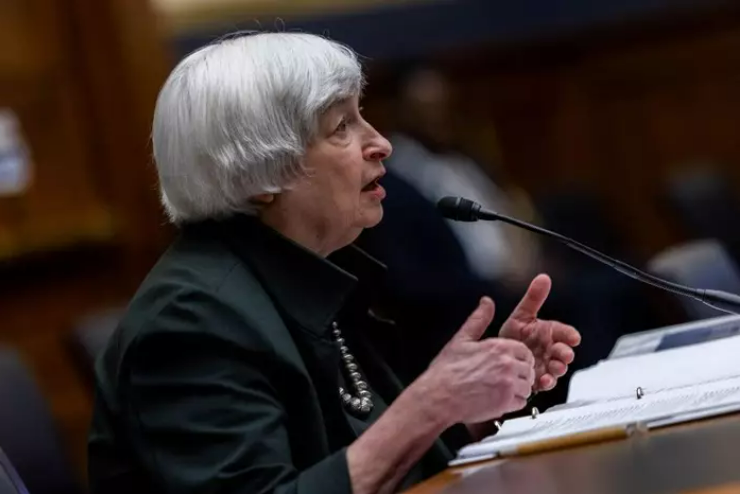
Jimmy Khan
May 13, 2022 09:56

The collapse of TerraUSD, one of the world's biggest stablecoins, sent ripples through cryptocurrency markets on Thursday, driving Tether below its dollar peg and bringing bitcoin to 16-month lows.
Cryptocurrencies have been caught up in a sell-off in risk assets that has gained traction this week as data revealed rising US inflation, escalating investor concerns about the economic implications of aggressive central bank tightening.
According to CoinMarketCap statistics, the overall market value of all cryptocurrencies has dropped to $1.2 trillion, less than half of what it was in November.
According to CoinMarketCap price data, Tether, a reserve-backed stablecoin that is meant to be linked 1:1 to the US dollar, fell as low as 95 cents earlier in the worldwide session. It was last available for 99 cents.
Despite the volatility, US Treasury Secretary Janet Yellen said that stablecoins like as Tether and TerraUSD do not now constitute a systemic danger to the financial system.
"I wouldn't describe it at this size as a significant danger to financial stability," she said at a House Financial Services Committee hearing, "but they're developing extremely quickly and they bring the same kinds of hazards we've seen for centuries in connection with bank runs."
Bitcoin, the most valuable cryptocurrency, fell to $25,401.05 on Thursday, its lowest level since December 28, 2020. It was last trading at $28,751, down 0.9 percent.
It has lost more than a quarter of its value in the last eight sessions, or roughly $10,700, and is down 37 percent this year, trading far below the record of $69,000 it reached in November 2021.
According to Refinitiv statistics, Bitcoin's correlation with the Nasdaq composite has lately increased and is currently around its all-time high. So far this month, the Nasdaq composite has down approximately 8%.
Ether, the world's second-largest cryptocurrency, hit a new low of $1,700, its lowest since June 2021.
Unlike earlier financial market sell-offs, when cryptocurrencies were mostly unaffected, the present selling pressure in digital currencies has cast doubt on the larger premise that they are reliable repositories of value in the face of market turbulence.
TerraUSD, a stablecoin, has been impacted by the instability and has broken its peg to the US dollar, plummeting as low as 31 cents on Wednesday. It was selling about 38 cents on Thursday.
"Unfortunately, the consequences of this event extend beyond the financial losses suffered by investors," said Anto Paroian, chief operating officer of crypto asset hedge fund ARK36.
"If not for the whole crypto world, but definitely for the stablecoins market, de-pegging will almost surely result in a significant regulatory risk."
Stablecoins are digital currencies that are linked to conventional assets like the US dollar. TerraUSD, on the other hand, is an algorithmic or "decentralised" stablecoin that was meant to keep its dollar peg by a complicated system that entailed replacing it with a free-floating token.
Following the collapse of Terra's algorithmic stablecoin and the linked Luna token on Thursday, the network's blockchain was paused to avoid assaults. However, the Terra blockade has subsequently been reopened.
Terraform Labs, the business behind the TerraUSD, has a non-profit partner called the Luna Foundation.
On Thursday, even stablecoins backed by conventional assets showed symptoms of stress.
According to CoinMarketCap statistics, Tether fell below its 1:1 dollar peg on Thursday, reaching a low of 95 cents around 0724 GMT.
Tether's chief technical officer, Paolo Ardoino, claimed in a Twitter Spaces conversation that the stablecoin has decreased its exposure to commercial paper in the previous six months and currently has the bulk of its reserves in US Treasury bonds.
Tether is the most valuable stablecoin by market capitalization, accounting for about 87 percent of the whole $169.5 billion stablecoin market, according to CoinMarketCap.
According to Denis Vinokourov, director of research at Corinthian Digital Asset Management, the enormous number of centralised cryptocurrency exchanges and decentralised venues, each with their own liquidity profile and credit risk, was contributing to price distortions throughout the market.
"The fragmented character of the market contributes to spillover effects into other stablecoins," Vinokourov stated.
The effect of TerraUSD's problems on investors is still being assessed by market participants.
The Federal Reserve of the United States cautioned on Tuesday in its biannual Financial Stability Report that stablecoins are susceptible to investor runs because they are backed by assets that might lose value or become illiquid in times of market stress.

May 12, 2022 10:09
